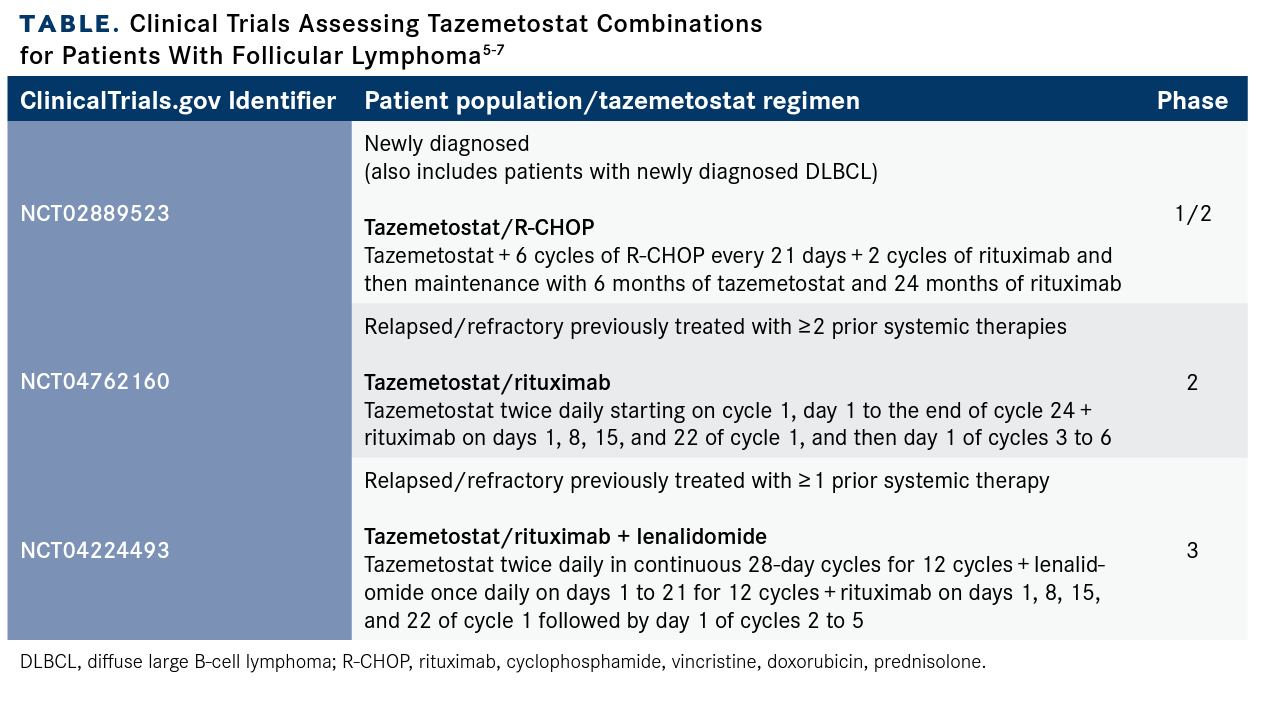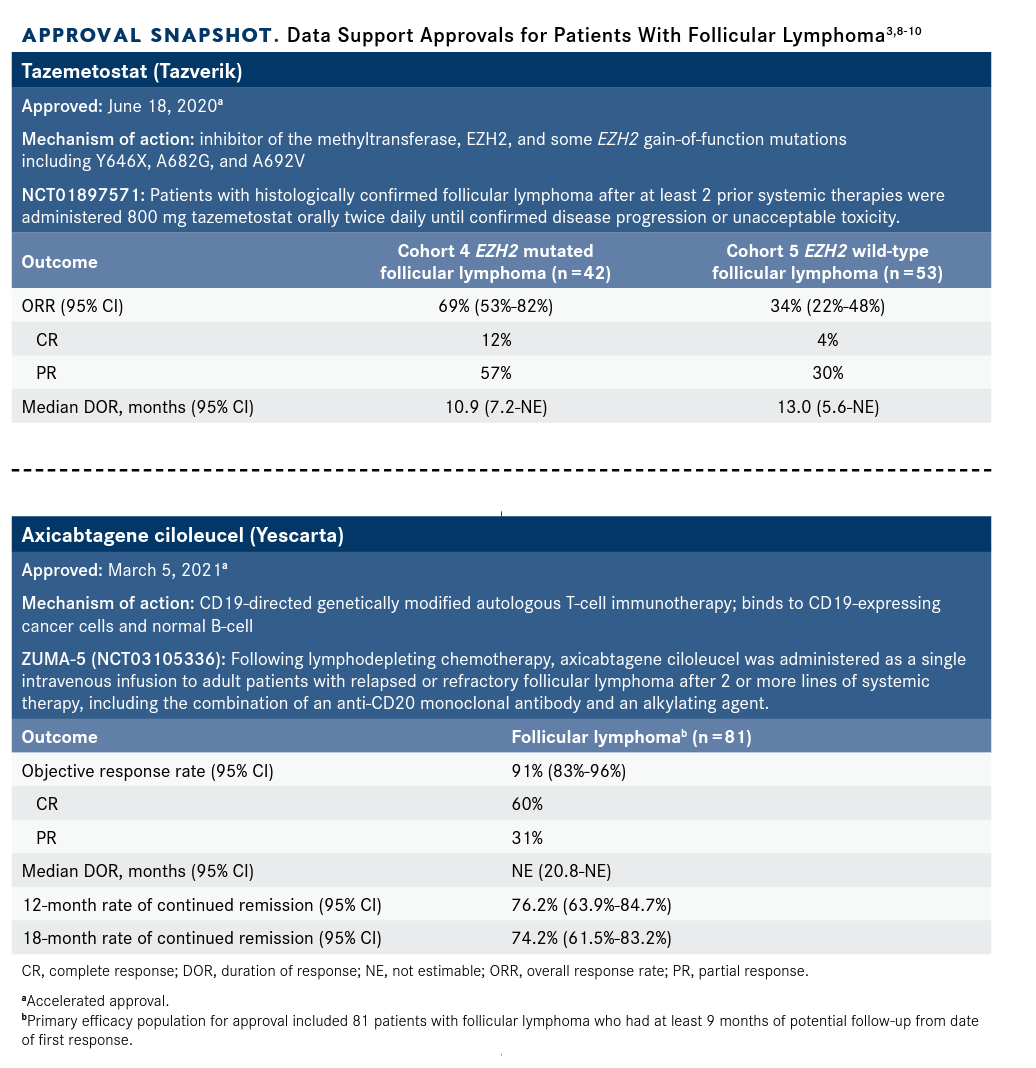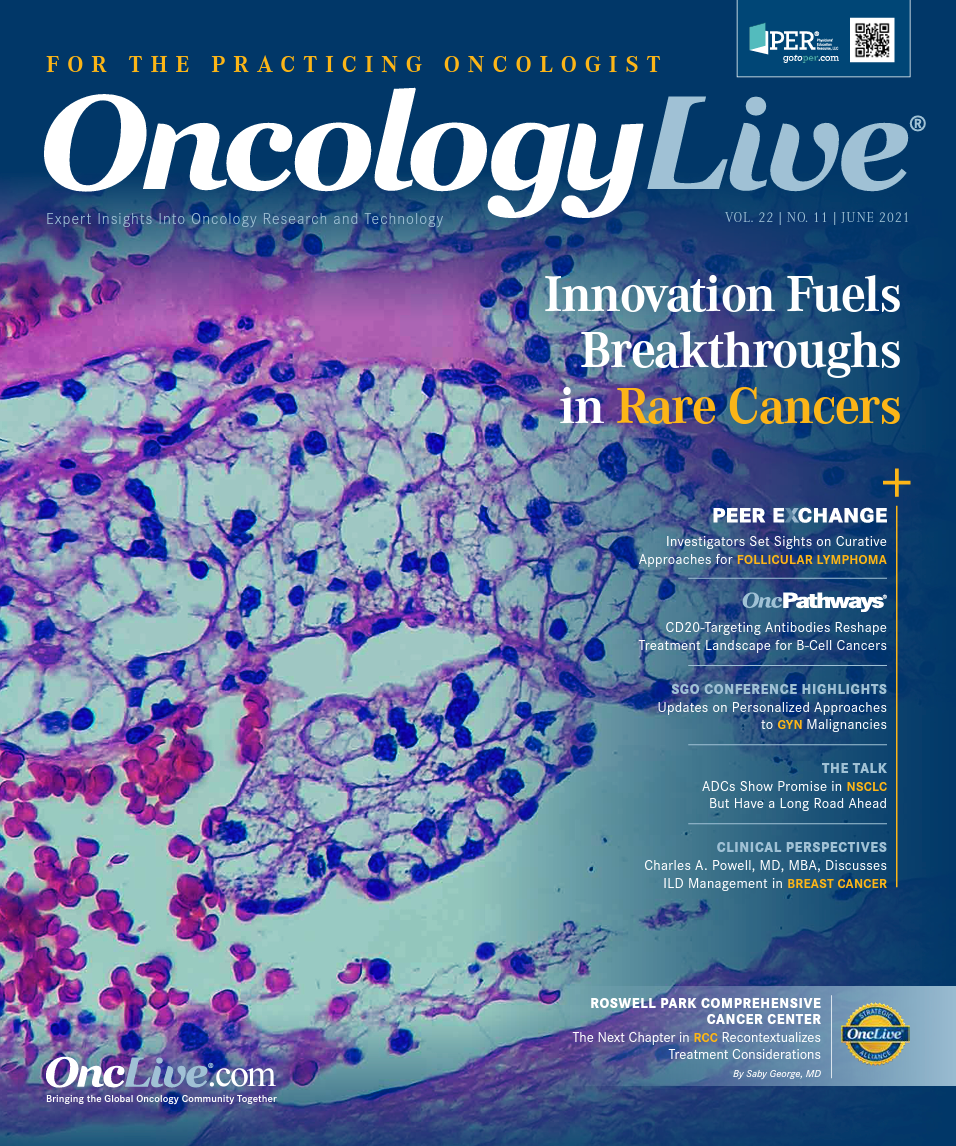Investigators Set Sights on Curative Approaches for Follicular Lymphoma
The majority of patients with indolent follicular lymphoma do well with observation and after first-line treatment, but approximately 20% experience disease progression within 2 years of their initial treatment, which is associated with a 50% risk of dying within 5 years. Subsequently, this is an area of unmet need but one in which considerable progress is being made.
Caron A. Jacobson, MD, MMSc

Follicular lymphoma, an indolent form of non-Hodgkin lymphoma, is associated with long remissions and a favorable prognosis; however, it is generally considered incurable in its advanced stages, which is when most cases are diagnosed.1,2 The majority of patients do well with observation and after first-line treatment, but approximately 20% experience disease progression within 2 years of their initial treatment, which is associated with a 50% risk of dying within 5 years.2 Subsequently, this is an area of unmet need but one in which considerable progress is being made.
During a recent OncLive Peer Exchange®, a panel of lymphoma experts discussed 2 recently approved treatments that are providing hope to patients with relapsed or refractory follicular lymphoma: tazemeto-stat (Tazverik) and axicabtagene ciloleucel (Yescarta). The approval of these agents and the anticipation of others on the horizon have paved a path toward more effective lines of treatment for patients with relapsed or refrac-tory disease. “With each year we have 2 or 3 new fields of therapy that are transforming the landscape,” Caron A. Jacobson, MD, MMSc, said. “We have all been concerned about patients in the third line and beyond, and now we’re concerned about patients in the fifth and sixth lines. That’s progress.”
Tazemetostat
The FDA granted accelerated approval to tazemetostat, an orally administered, first-in-class small molecule EZH2 inhibitor, on June 18, 2020.3 “Approximately 20% of patients with follicular lymphoma will have an EZH2 mutation,” Loretta J. Nastoupil, MD, said. Although tazemetostat is approved for patients with and without EZH2 mutations, she noted, the overall response rate (ORR) was significantly higher in those with mutations. “That may speak to the fact that the gain of function mutations might be leading to excessive proliferation in the B-cell maturation process, but there’s also likely a component of the microenvironment,” she said.
Currently, tazemetostat is approved for adult patients with relapsed or refractory follicular lymphoma that is positive for an EZH2 mutation on an FDA-approved test and who have been previously treated with at least 2 systemic therapies, as well as for adult patients with relapsed or refractory disease who have no satisfactory alternative treatment options.3 Despite the agent’s approval for patients with and without EZH2 mutations, the panelists agreed that they like to know a patient’s mutation status because it helps them with treatment decision-making, including sequencing.
“If someone is mutated, [tazemetostat] probably follows right behind R2 [rituximab (Rituxan) and lenalidomide (Revlimid)] therapy for me—in many instances, ahead of PI3K, etc—whereas if I know it’s not and I’m confident in that test, I might place it behind PI3K inhibition,” Andrew M. Evens, DO, MSc, said, noting that these decisions involve a variety of other considerations, including possible drug interactions and toxicities.
The urgency of a meaningful clinical response is another important factor in treatment decision-making, the panelists noted. “For a patient who really needs a response, who is very close to having disease that could be quite symptomatic or could potentially affect organ function, I would be much more comfortable treating with an EZH2 inhibitor if they had an EZH2 mutation. I’d be much more confident that they’d have a meaningful clinical response than if they were EZH2 wild-type,” Jacobson said. “But if the patient is stable and you could wait to see if they have a response, I probably would reach for something like tazemetostat first because of its safer safety profile, regardless of whether they had an EZH2 mutation.”
The panelists explained that EZH2 is easy to test for because it is a stable mutation that occurs early on, enabling testing on archival or new tumor specimens. “Even patients who have transformed follicular lymphoma to large B-cell lymphoma often maintain that EZH2 mutation,” moderator Ian W. Flinn, MD, PhD, explained.
Tazemetostat was approved based on data from 2 open-label, single-arm cohorts in study E7438-G000-101 (NCT01897571): cohorts 4 and 5, which included patients with EZH2mutated (n = 45) and EZH2 wild-type (n = 54) follicular lymphoma, respectively.3,4 “Patients who were enrolled in the trial had to have at least 2 prior lines of therapy. This trial uniquely took all-comers. It included patients with stage IIIB disease. There was a small number of patients with what we would call high-grade follicular lymphoma,” Krish Patel, MD, said.
After a median follow-up of 22 months in the mutation cohort and 35.9 months in the wild-type cohort, the ORR was 69% in the mutation cohort (95% CI, 53%-82%), with 12% being complete responses (CRs) and 57% being partial responses (PRs), compared with 35% in the wild-type cohort (95% CI, 23%-49%), with 4% being CRs and 30% being PRs.3,4 However, Patel noted that duration of response (DOR) and progression-free survival (PFS) were more similar between these cohorts. The median DOR was 10.9 months in the mutation cohort (95% CI, 7.2–not estimable [NE]) vs 13.0 months in the wild-type cohort (5.6-NE), whereas the median PFS was 13.8 months (95% CI, 10.7-11.0) vs 11.1 months (95% CI, 3.7-14.6) in these cohorts, respectively.
“The toxicity profile of [tazemetostat] is what should probably excite most of us. In the single-agent study, the drug was extremely well tolerated,” Patel said. The most common (≥ 20%) treatment-related adverse events (AEs) included fatigue, upper respiratory tract infection, musculoskeletal pain, nausea, and abdominal pain.
“We see very few rates of grade 3 or higher toxicity and very low rates of dose modifications and treatment discontinuations as a result of toxicity,” Nastoupil said. Among both cohorts (N = 99), treatment-related grade 3 or worse AEs included thrombocytopenia (3%), neutropenia (3%), and anemia (2%), with serious treatment-related AEs reported in 4%.4 There were no treatment-related deaths. “The goal of care is to extend life but also make sure that it comes with good quality of life. That’s something you can achieve with this therapy,” she added.
The panelists agreed that tazemetostat is an ideal candidate to be combined with other agents. “As we start to look at [its] mechanism of action and how you might target that with combination strategies, the safety profile suggests that you should be able to combine this and not have significant additive toxicity. So, as a single agent, it’s attractive, [but] it’s potentially more attractive when you start to combine it with other things,” Nastoupil said. Several clinical trials are recruiting patients to assess tazemetostat in various combination approaches for patients with follicular lymphoma (TABLE5-7).
TABLE. Clinical Trials Assessing Tazemetostat Combinations for Patients With Follicular Lymphoma5-7

Axicabtagene ciloleucel
Axicabtagene ciloleucel, or axi-cel, is a CD19-directed chimeric antigen receptor (CAR) T-cell therapy that includes CD28 and CD3-ζ costimulatory molecules.8 On March 5, 2021, the FDA granted axi-cel accelerated approval for the treatment of adults with relapsed or refractory follicular lymphoma who had been previously treated with at least 2 lines of systemic therapy, including the combination of an anti-CD20 monoclonal antibody and an alkylating agent.9 Approval was based on data from the single-arm, open-label, multicenter ZUMA-5 trial (NCT03105336).9
“[ZUMA-5] included both patients with follicular lymphoma and those with marginal zone lymphoma, but when you look just at the follicular lymphoma cohort, the response rate was 94%, with an 80% CR rate. That’s probably one of the highest CR rates we’ve seen in this multiple relapsed/refractory setting,” Jacobson said, noting that responses appear durable.
“The median follow-up for duration of response was 17.5 months. Looking specifically at 12 months, 72% of patients with follicular lymphoma remained responsive to treatment,” she added, noting that longer follow-up is needed to see if this treatment can change the disease’s natural history. If this is possible, the treatment may transform outcomes for patients in later lines of therapy. Jacobson noted that these early results are encouraging, especially since responses were seen across all risk groups, including patients with disease progression within 2 years of treatment, and some evidence suggests that CAR T-cell therapy may have curative potential for some patients with relapsed/refractory follicular lymphoma.
“We don’t know if there’s a plateau in this disease. What we do know is that some of the early, single-institution, phase 1, first-in-human studies of these CD19 CAR T-cell therapies did treat some patients with follicular lymphoma, some of which are 10 [or more] years out [from therapy]. That’s proof of principle that a subset of these patients is going to be cured with CAR T-cell therapy. We just don’t know if it’s going to be 5%, 40%, 70%,” Jacobson said.
APPROVAL SNAPSHOT. Data Support Approvals for Patients With Follicular Lymphoma3,8-10

AEs of special interest with axi-cel include cytokine release syndrome (CRS) and neurological toxicities, with the prescribing information including a boxed warning.8 Jacobson explained that although data from axi-cel studies have revealed CRS and neurologic toxicities in a substantial proportion of patients when considering non-Hodgkin lymphoma collectively, these toxicities, particularly grade 3 or higher events, occur less frequently in those with follicular lymphoma vs other forms of non-Hodgkin lymphoma, such as diffuse large B-cell lymphoma. “The rates of grade 3 and higher CRS, which is ICU [intensive care unit]level CRS, were only 6% in the follicular lymphoma cohort. The rates of grade 3 and higher neurological toxicity were about half of what we see in large B-cell lymphoma, [which is approximately] 15%,” she said, noting that there is a biological reason for patients with follicular lymphoma having less severe AEs.
“We know that high-grade CRS and neurological toxicity is increased in patients who have high pretreatment inflammatory markers. In our patients with follicular lymphoma, the pretreatment CRP [C-reactive protein] and ferritin and IL-6 levels are much lower than what they are in large B-cell lymphoma,” Jacobson said.
When discussing candidacy for CAR T-cell therapy and some of the challenges that it poses, Nastoupil pointed out that it can be severely disruptive to patients’ normal daily lives. “Sometimes there is a requirement for patients to relocate to another city. They must have a caregiver. They must be away from work and employment for a minimum of 4 weeks. Even in my practice, I recognize that there are patients for whom it’s just not feasible,” she said. However, because it is a one-time therapy, Nastoupil said some patients have a lot of incentive to go through with it, especially in the fourth or later line, as it likely provides the best PFS in that setting.
References
- Freedman A, Jacobsen E. Follicular lymphoma: 2020 update on diagnosis and management. Am J Hematol. 2020;95(3):316-327. doi:10.1002/ajh.25696
- Casulo C, Nastoupil L, Fowler NH, Friedberg JW, Flowers CR. Unmet needs in the first-line treatment of follicular lymphoma. Ann Oncol. 2017;28(9):2094-2106. doi:10.1093/annonc/mdx189
- FDA granted accelerated approval to tazemetostat for follicular lymphoma. FDA. June 18, 2020. Accessed May 15, 2021. https://www.fda.gov/drugs/fda-granted-accelerated-approval-tazemetostat-follicular-lymphoma
- Morschhauser F, Tilly H, Chaidos A, et al. Tazemetostat for patients with relapsed or refractory follicular lymphoma: an open-label, single-arm, multicentre, phase 2 trial. Lancet Oncol. 2020;21(11):1433-1442. doi:10.1016/S1470-2045(20)30441-1
- Study of tazemetostat in newly diagnosed diffuse large B cell and follicular lymphoma patients treated by chemiotherapy (Epi-RCHOP). ClinicalTrials.gov. Updated January 6, 2021. Accessed May 15, 2021. https://clinicaltrials.gov/ct2/show/NCT02889523
- A trial to examine combination of tazemetostat and rituximab for patients with recurrent/refractory follicular lymphoma. ClinicalTrials.gov. Updated February 21, 2021. Accessed May 15, 2021. https://clinicaltrials.gov/ct2/show/NCT04762160
- Study in subjects with relapsed/refractory follicular lymphoma. ClinicalTrials.gov. Updated January 7, 2021. Accessed May 15, 2021. https://clinicaltrials.gov/ct2/show/NCT04224493
- Yescarta. Prescribing information. Kite Pharma Inc; 2021. Accessed May 17, 2021. https://www.fda.gov/media/108377/download
- FDA grants accelerated approval to axicabtagene ciloleucel for relapsed or refractory follicular lymphoma. FDA. Updated March 8, 2021. Accessed May 16, 2021. https://www.fda.gov/drugs/drug-approvals-and-databases/fda-grants-accelerated-approval-axicabtagene-ciloleucel-relapsed-or-refractory-follicular-lymphoma
- Jacobson C, Chavez JC, Sehgal A, et al. Primary analysis of ZUMA-5: a phase 2 study of axicabtagene ciloleucel (axi-cel) in patients with relapsed/refractory indolent non-Hodgkin lymphoma. Blood. 2020;136(suppl 1):40-41. doi:10.1182/blood-2020-136834




